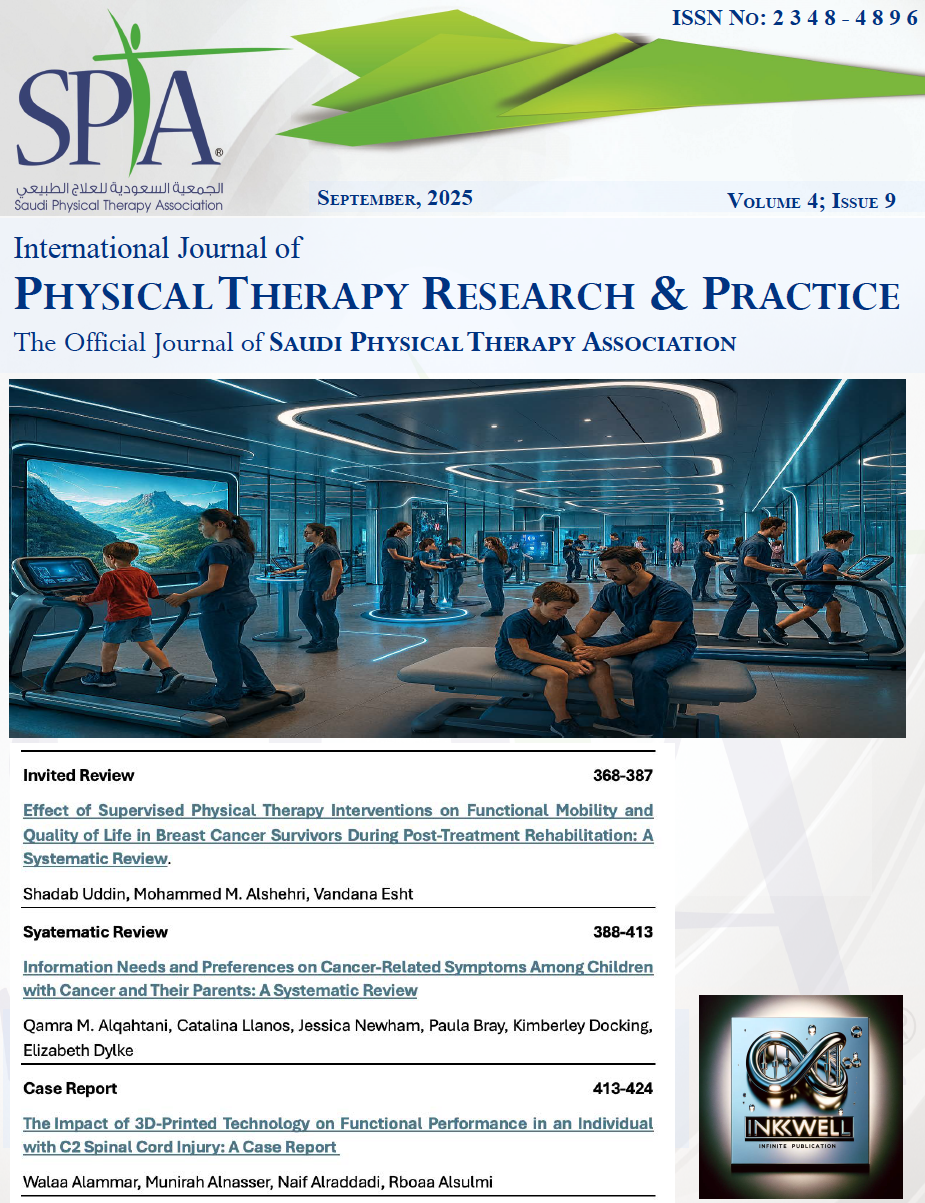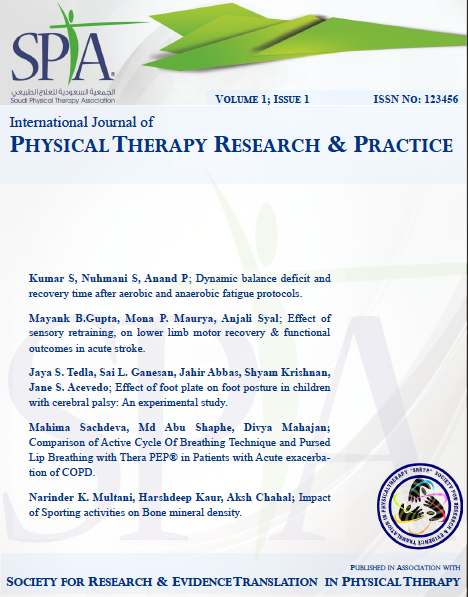The Impact of 3D-Printed Technology on Functional Performance in an Individual with C2 Spinal Cord Injury: A Case Report
DOI:
https://doi.org/10.62464/hvjpn732Keywords:
Wheelchair joystick, C2 spinal cord injury, Functional Independence Measure, 3D printing, FDMAbstract
This case report describes the use of a 3D-printed wheelchair joystick to improve functional performance in an individual with incomplete traumatic spinal cord injury at C2. A 29-year-old man presented with complete tetraplegia and no residual upper extremity function following a traffic accident, rendering him unable to operate manual or electric wheelchairs. To address this limitation, a joystick adapted for residual shoulder movements was developed using fused deposition modeling with polylactic acid material. After training, the patient achieved proficiency in maneuvering the wheelchair, as assessed with the Functional Independence Measure, enabling safe navigation and increased engagement in daily activities. This case illustrates how 3D-printed assistive devices can enhance functional autonomy and community participation in individuals with high cervical spinal cord injury.
References
Abu-Baker, N. N., Al-Zyoud, N. H., & Alshraifeen, A. (2021). Quality of life and self-care ability among individuals with spinal cord injury. Clinical Nursing Research, 30(6), 883–891. https://doi.org/10.1177/1054773820976623.
Foy, T., Perritt, G., Thimmaiah, D., Heisler, L., Offutt, J. L., Cantoni, K., Hseih, C.-H., Gassaway, J., Ozelie, R., & Backus, D. (2011). The SCIRehab project: treatment time spent in SCI rehabilitation. Occupational therapy treatment time during inpatient spinal cord injury rehabilitation. The Journal of Spinal Cord Medicine, 34(2), 162–175. https://doi.org/10.1179/107902611X12971826988093.
Arsh, A., Anwar, Z., Zeb, A., & Ilyas, S. M. (2020). Effectiveness of occupational therapy in improving activities of daily living performance in complete cervical tetraplegic patients; A quasi experimental study. Pakistan Journal of Medical Sciences Quarterly, 36(2), 96–99. https://doi.org/10.12669/pjms.36.2.1002.
Keusen, P., Vuilliomenet, T., Friedli, M., & Widmer, M. (2023). Age at onset of spinal cord injury is associated with increased inpatient care needs, reduced independence at discharge and a higher risk of institutionalization after primary inpatient rehabilitation. Journal of Rehabilitation Medicine: Official Journal of the UEMS European Board of Physical and Rehabilitation Medicine, 55, jrm00353. https://doi.org/10.2340/jrm.v54.4468.
Hunzeker, M., & Ozelie, R. (2021). A cost-effective analysis of 3D printing applications in occupational therapy practice. The Open Journal of Occupational Therapy, 9(1), 1–12. https://doi.org/10.15453/2168-6408.1751.
Christiansen E, C. H. A. (2010). Introduction to occupation: The art and science of living. Pearson Education.
Biering-Sørensen, F., Nielsen, J. B., & Klinge, K. (2006). Spasticity-assessment: a review. Spinal Cord, 44(12), 708–722. https://doi.org/10.1038/sj.sc.3101928.
Brown, M., Hislop, H., & Avers, D. (2013). Daniels and Worthingham’s muscle Testing-E-Book: Techniques of manual examination and performance testing. Elsevier Health Sciences.
Uniform Data System for Medical Rehabilitation. (2018). The FIM System® Clinical Guide, (Version 5.2.1). Buffalo: UDSMR.
Stadnyk, R., Townsend, E., & Wilcock, A. (2010). Occupational justice. In C. H. Christiansen & E. A. Townsend (Eds.), Introduction to occupation: The art and science of living (2nd ed., pp. 329–358). Upper Saddle River, NJ: Pearson Education.
Scivoletto, G. (2022). Predicting outcomes following cervical spine trauma. Indian Spine Journal, 5(1), 69–81. https://doi.org/10.4103/isj.isj_29_21.
Consortium for Spinal Cord Medicine (2000). Outcomes following traumatic spinal cord injury: clinical practice guidelines for health-care professionals. The journal of spinal cord medicine, 23(4), 289–316. https://doi.org/10.1080/10790268.2000.11753539
tecla. (2024, March 7). tecla-e Sip-and-Puff Switch Kit. gettecla.com. https://gettecla.com/products/sip-and-puff-switch-kit?variant=40853966586038
Hojin, K. (2019). Thingiverse.com. https://www.thingiverse.com/thing:4069529
van Leeuwen, C. M., Kraaijeveld, S., Lindeman, E., & Post, M. W. (2012). Associations between psychological factors and quality of life ratings in persons with spinal cord injury: a systematic review. Spinal cord, 50(3), 174–187. https://doi.org/10.1038/sc.2011.120
Chae, D. S., Kim, D. H., Kang, K. Y., Kim, D. Y., Park, S. W., Park, S. J., & Kim, J. H. (2020). The functional effect of 3D-printing individualized orthosis for patients with peripheral nerve injuries: Three case reports. Medicine, 99(16), e19791. https://doi.org/10.1097/MD.0000000000019791
Shin, H. D., Ahn, D. H., Lee, H. A., Lee, Y. K., Yang, H. S., Jo, M., Lee, S. B. N., Park, G. S., Hwang, Y. S., Sim, W. S., & Park, S. J. (2021). Customized Power Wheelchair Joysticks Made by Three-Dimensional Printing Technology: A Pilot Study on the Environmental Adaptation Effects for Severe Quadriplegia. International journal of environmental research and public health, 18(14), 7464. https://doi.org/10.3390/ijerph18147464
Alve, Y. A., & Bontje, P. (2019). Factors Influencing Participation in Daily Activities by Persons With Spinal Cord Injury: Lessons Learned From an International Scoping Review. Topics in spinal cord injury rehabilitation, 25(1), 41–61. https://doi.org/10.1310/sci2501-41
Smith, J., Doe, A., & Lee, R. (2020). Limitations of case report studies and the importance of long-term follow-up. Journal of Medical Research, 45(3), 123–130.
Downloads
Published
Issue
Section
License
Copyright (c) 2025 International Journal of Physical Therapy Research & Practice

This work is licensed under a Creative Commons Attribution-NonCommercial-NoDerivatives 4.0 International License.




